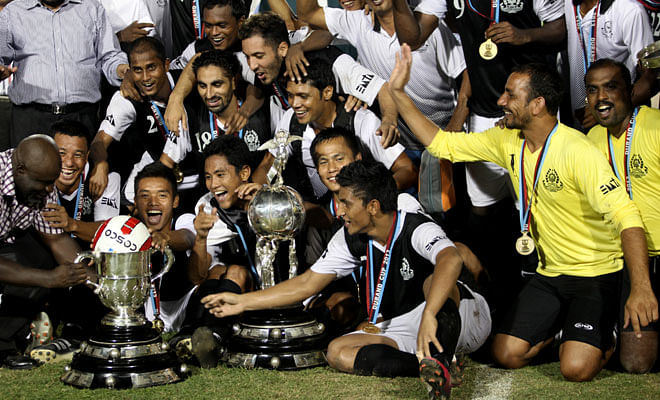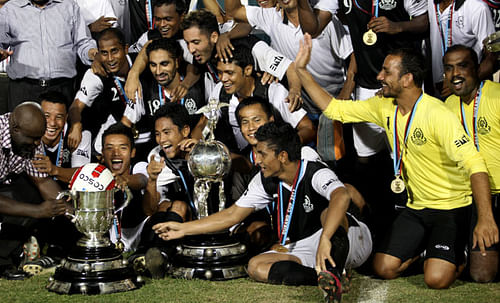
Mohammedan Sporting: A football club with legacy that needs understanding

Football cringes at the news of a team disbanding, particularly if it owns a significant historical factor. The news on one of Kolkata’s most legendary club Mohammedan Sporting dissolving saw people from across the football spectrum pay tribute to the Black Panthers who, at one point, carried Indian football. Mohammedan Sporting Club was to seize all activity till further notice.
One would argue that it was the men in Black and White who enduringly diverted attention from the British teams in Indian football. As the years passed on, football fans in the country have witnessed a number of blustering football teams, but very few have succeeded in acquiring an aura that the team of 1930’s had. They were invincible, unbeatable and hence cemented themselves in the hearts of many across India.
But does anyone really own Mohammedan SC’s legacy?
In 1887, Irish Marist Brother Walfrid, with a purpose of relieving poverty within the immigrant Irish community in the East End of Glasgow created what we know today as Celtic FC. Approximately, 5,000 miles away, Khan Bahadur Aminul Islam along with a few others, had founded the Jubilee Club, with a similar intention of providing a platform for the significant Muslim population in Kolkata.
Within a period of four years, the club had gone through several name changes with first being the “Crescent Club” the universal symbol of Muslim solidarity to “Hamidia Club” to finally settling down with “Mohammedan Sporting Club” in 1891.
In the early stages, it was strictly a fight for Mohammedan’s survival as the financial condition of the club was meager. Had it not been for the cause of the common “Musalman” (Muslim), the club would cease to exist. Majority of the members of the club, at the time, did not pay any dues with collections, if any, being around Rs. 25 – 30.
Despite a series of positive performances in their indispensible like existence since the club’s realization, 1927 was the most significant of all. This is when Mohammedan was promoted to the second division of the Calcutta Football League. Concurrently, the financial condition of the club seemed to be improving, as it banked on donations trickling in from across the country, under their general scheme of providing a social platform for Muslims.
As the country was slowly drawing up the courage to fight for freedom, every entity being formed had a political inclination, be it through art, sports or culture. On similar lines, Mohammedan was known to be anti-Congress, Congress being in the front lines in the push for independence.
But on the field, the club pushed its dogmatic feelings to the side, and showed its appreciation for the game in its sincerest form. After Mohun Bagan’s (club with Hindu & Muslim following) historic win against East Yorkshire Regiment in 1911 in the IFA shield, the members of the club “were almost mad and rolling on the ground with joyous excitement on the victory of their Hindu brethren.”
During that period, the concept of communalism did not exist in the realms of football with top 3 clubs of Kolkata, being loved by both populations. However, it was not until 1934, which is when the communal factor was introduced into football clubs. It was only natural for Mohammedan Sporting to ride the wave of Muslim support the club was generating. By mid 1930’s, the game was never about the British against the Indians but more like the Hindu’s (via Mohun Bagan and East Bengal) versus the Muslims.

1934 also saw the club reach the heights that it was destined to after winning the Calcutta Football League for the first time. This also saw the club become the first “Indian” club to break the monopoly of British football in the country, in terms of league play. Their hot streak continued for five years until Mohun Bagan AC displaced them in 1939. Their success could be attributed to two significant reasons. By this time, talented players from across the country were invited to join the cause – the cause of playing for a Muslim club.
And many responded. Star players that made the trip to Kolkata to join this growing bandwagon included Jumma Khan (known as the Chinese Wall), Rahamat (known as the Magician) and the bare-footed amateur – Mohammed Salim. It wasn’t until 1943, when the Prince of Nepal became the first Hindu player to adorn the colors of the club. Secondly, it was the only team, which had a strategy in place in regards to players participating with boots on. When the pitch was dry, the players would play bare feet, and when it rained, boots were worn.
Mohammedan’s consistent performances drew the crowds in numbers. The Musalman’s now had something to cheer for in the wake of the notorious Mohammedan Sporting Club, as it became the symbol of Muslim aspirations. Their popularity extended from beyond the boundaries of Bengal towards the entire nation, all the while becoming a strong voice against the British oppression.
In the larger context, the achievements of the club were seen as a victory for all Indians, despite of their creed, caste and ethnicity. But there was a communal twist to it. Many between both communities, regarded the club’s success as that of a Muslim victory over the Hindus, however there were many others who considered this as an Indian victory over British omnipotence on the field.
The chant of the club supporter’s every time they played against a British opposition stood out as such:
“Mohammedan Sporting tumko lakho lakho salam, humlog desh ka badsha hua, aur sab hain gulam”
“Mohammedan Sporting – Thousands and thousands of peace and blessings upon you, we have become the kings of the nation and all are slaves”
Such was the legacy of Mohammedan Sporting.
Since then the social dogma within the region had changed. After the partition in 1947, the club lost many of its elite Muslim patrons, who chose to move to newly formed Pakistan. Till the 70’s, football was the way out to a better life. But Cricket was slowly taking over. Moreover, by then a teen from an average income family would rather follow Manchester United on the television than Mohammedan Sporting on the field.
The financial condition of Kolkata’s top 3 remained to be in jeopardy. Top management refused to change their ways of working with principal funding coming from a particular individual (most likely a politician) who aimed to seek instant recognition socially. The players would go unpaid for months at a time and by the time, one would get to know the coach, he would be fired. Moreover, having the Prophet’s name attached to Mohammedan Sporting, did not help either. The club could not accept funding from the liquor brands that sponsored Kolkata’s two other clubs, East Bengal and Mohun Bagan. Hence, the club’s fate does not come as a surprise.
Yet, as it stood before the advent of the Indian Super League, if you were to attend a Kolkata derby today, the stadium would have at least 70,000 people shouting their hearts out. For those 90 minutes one would witness a mannered battle of sorts, if not war.
Since announcing the folding of the club a few weeks ago, well-wishers from across the world had offered to help in reviving the fortunes of the club and keeping it alive, temporarily. Even sponsors have come in knocking. But will it be sustainable?
The club’s significance to the world of Indian football is evident. Ex-Indian international footballer Chuni Goswami was quoted in the Times of India saying, “Mohun Bagan, Mohammedan Sporting, and East Bengal, all form a distinct identity. We flourished because of the other and our rivalries made what we are. If one goes, the others too will likely to follow. I don’t know where it will end.”
Mohammedan Sporting is and will always be a football icon, but surely the clubs legacy belongs to all those who seek to maintain the heritage by fighting for what the club stood for.
FYI: It was because of that Scottish club 5,000 miles away, mentioned earlier, which saw the twinkle toes of Mohammed Salim become the first player from the sub-continental region to play and score for a European club.
This piece could not be completed if it wasn’t for the extensive work done by Kausik Bandyopadhyay, a History teacher at West Bengal State University in India, on the history of Mohammedan Sporting.